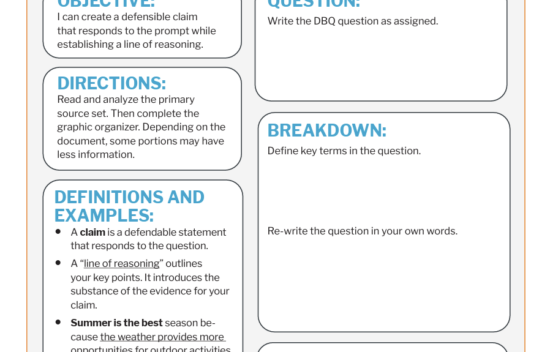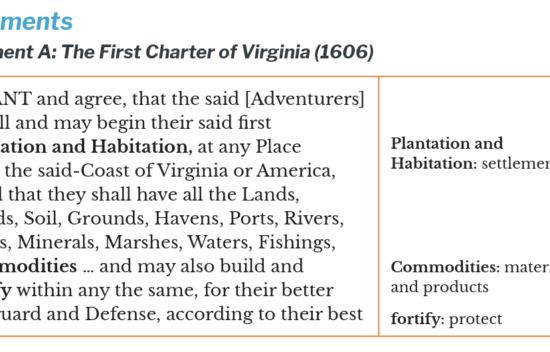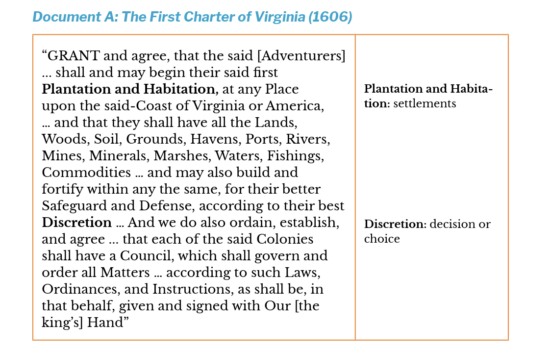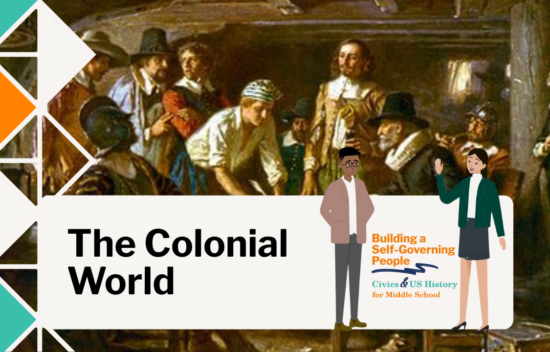
Unit 1: Thesis Deconstructed DBQ – Mini-Lesson
Lesson Components
Guiding Question:
- How did different groups, such as religious communities, traders, and settlers in the American colonies, establish and practice self-government?
Objectives:
- Students will define and understand the purpose of a thesis in historical writing.
- Students will analyze primary sources to develop a thesis in response to a historical question.
- Students will use a graphic organizer to outline their line of reasoning.
Student Resources
Documents (choose a set):
- Unit 1: Deconstructed DBQ Assignment Sheet and Document Set Handout Set
- Unit 1: Scaffolded Deconstructed DBQ Assignment Sheet and Document Set Handout Set
Graphic Organizer
Teacher Resources:
Facilitation Notes
- This is a mini-lesson. It is intended to be short and directly related to a specific skill. It will take 30-45 minutes of class time. It accompanies the mini-lesson slide deck.
- This lesson is intended to lead students through the process of creating a thesis with a specific claim and established line of reasoning. Students coming from the elementary level will likely be familiar with topic sentences or thesis statements, but they are likely to use broad, general statements. If your students do not need this scaffolding, the Thesis Deconstructed DBQ Graphic Organizer alone may provide them with enough support, without the need for the direct instruction used in this lesson.
Anticipate (Optional)
Deconstructed DBQ Skill Video
- Assign, or watch as a whole group, the Deconstructed DBQ video for the unit.
- The video will introduce a new primary source from the time period, give historical context and analysis, and then lead students through using the source to answer the Deconstructed DBQ question with a thesis statement.
- Pause the video at the processing questions embedded in the video to prompt reflection and discussion.
Teacher Note: The Deconstructed DBQ videos work as a pre-teaching tool, but can also be used as a scaffolding support later in the mini-lesson. The video is based on a source not included in the Deconstructed DBQ document set, so that this video can be used as a resource in classrooms using the DBQ for skills building, assessment, or both.
Engage
- Begin by defining thesis: a defensible claim that establishes a line of reasoning.
- Explain the components of a strong thesis:
- A claim that responds directly to the question.
- A line of reasoning that outlines key points.
- Use the example from the slide:
- Summer is the best season because the weather provides more opportunities for outdoor activities, people are more likely to travel to new places, and school is out.
- Ask students to identify the claim and the reasoning.
- Point out that summer could be replaced if someone had a different opinion, but the structure of the thesis remains the same. A claim with a line of reasoning.
Explore
Primary Source Analysis
- Distribute the Document Set (Documents A-D).
- Students will work in pairs or small groups to analyze one of the following documents:
- Document A: The First Charter of Virginia (1606)
- Document B: The Mayflower Compact (1620)
- Document C: The Charter of Maryland (1632)
- Document D: The Frame of Government of Pennsylvania (1682)
- Students will identify whether their document illustrates the establishment or practice of self-government.
- Groups will share their findings with the class.
Teacher Note: To provide flexibility, there is a blank slide and a filled slide for sorting the documents available in the slide deck.
Developing a Thesis
- As a class, use the graphic organizer to categorize evidence from the documents into:
- Establishing self-government (First Charter of Virginia, Charter of Maryland)
- Practicing self-government (Mayflower Compact, Frame of Government of Pennsylvania)
- Guide students in crafting a sample thesis statement using the identified evidence. Example:
- Colonists established self-government through official charters that granted them governing authority and practiced self-government through representative assemblies and mutual agreements, such as the Mayflower Compact.
- Have students individually draft their own thesis statements using the Deconstructed DBQ: Thesis Handout
Scaffolding note: There is another example in the slide deck that can be used with more advanced students using three categories of evidence and a more sophisticated claim.
Closing
- Students will participate in a brief peer review, exchanging thesis statements and providing feedback using the following questions:
- Does the thesis answer the question?
- Is the claim clear and defensible?
- Does it establish a logical line of reasoning?
- Wrap up by discussing key takeaways and how thesis writing applies to historical analysis.
Assess & Reflect
- Completed Thesis Statement
- The completed handout with thesis statement acts as the summative assessment for this mini-lesson and the unit assessment.
- AND/OR
- Reflection: Exit slip – What is one thing you learned today about writing a strong thesis?
Extend (Optional)
- For advanced students: Have them incorporate additional evidence or refine their thesis to address counterarguments.
- For struggling students: Provide sentence starters for thesis writing or allow them to verbally explain their reasoning before writing.




